technical specifications Abarth 500 2011 Owner handbook (in English)
[x] Cancel search | Manufacturer: ABARTH, Model Year: 2011, Model line: 500, Model: Abarth 500 2011Pages: 170, PDF Size: 3.5 MB
Page 73 of 170
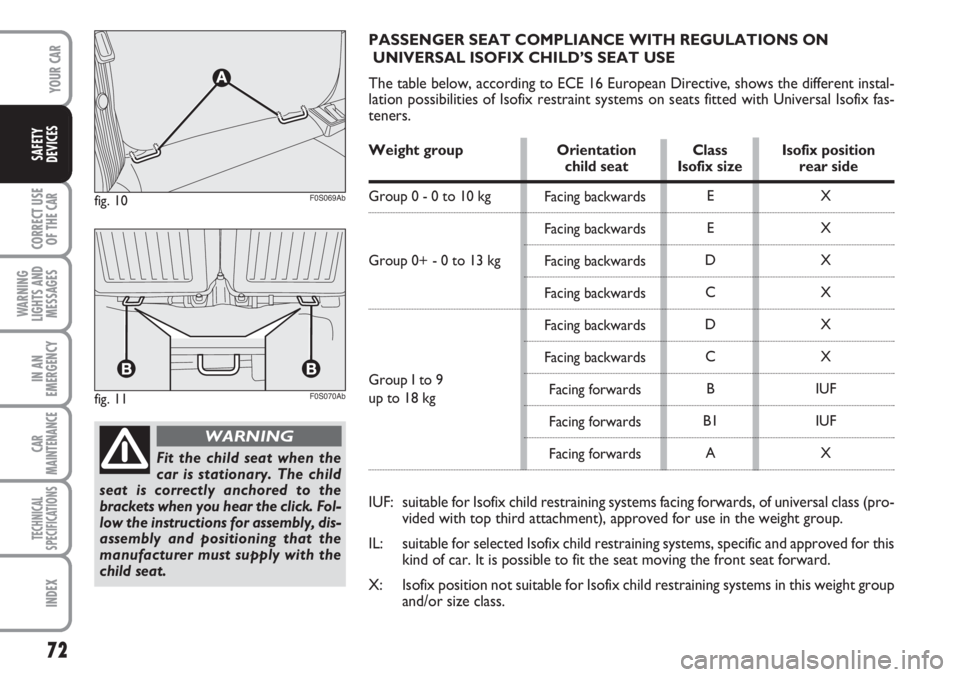
72
CORRECT USE
OF THE
CAR
WARNING
LIGHTS AND
MESSAGES
IN AN
EMERGENCY
CAR
MAINTENANCE
TECHNICAL
SPECIFICATIONS
INDEX
YOUR CAR
SAFETY
DEVICES
Fit the child seat when the
car is stationary. The child
seat is correctly anchored to the
brackets when you hear the click. Fol-
low the instructions for assembly, dis-
assembly and positioning that the
manufacturer must supply with the
child seat.
WARNING
fig. 10F0S069Ab
fig. 11F0S070Ab
E
E
D
C
D
C
B
B1
A
IUF: suitable for Isofix child restraining systems facing forwards, of universal class (pro-
vided with top third attachment), approved for use in the weight group.
IL: suitable for selected Isofix child restraining systems, specific and approved for this
kind of car. It is possible to fit the seat moving the front seat forward.
X: Isofix position not suitable for Isofix child restraining systems in this weight group
and/or size class. PASSENGER SEAT COMPLIANCE WITH REGULATIONS ON
UNIVERSAL ISOFIX CHILD’S SEAT USE
The table below, according to ECE 16 European Directive, shows the different instal-
lation possibilities of Isofix restraint systems on seats fitted with Universal Isofix fas-
teners.
Weight group Orientation Class Isofix positionchild seat Isofix size rear side
Group 0 - 0 to 10 kg
Group 0+ - 0 to 13 kg
Group I to 9
up to 18 kg
X
X
X
X
X
X
IUF
IUF
X Facing backwards
Facing backwards
Facing backwards
Facing backwards
Facing backwards
Facing backwards
Facing forwards
Facing forwards
Facing forwards
Page 74 of 170

73
CORRECT USE
OF THE
CAR
WARNING
LIGHTS AND
MESSAGES
IN AN
EMERGENCY
CAR
MAINTENANCE
TECHNICAL
SPECIFICATIONS
INDEX
YOUR CAR
SAFETY
DEVICES
AIRBAGS
The car is provided with front air bags for
the driver and the passenger, driver’s
knees air bag and side bags - window bags.
FRONT AIRBAGS
The front airbags (driver’s, passenger’s,
driver’s knees air bags) have been designed
to protect the occupants in the event of
head-on crashes of medium-high severity,
by placing the cushion between the occu-
pant and the steering wheel or dashboard.
Front air bags are designed to protect
car’s occupants in front crashes and there-
fore non-activation in other types of col-
lisions (side collisions, rear shunts, roll-
overs, etc.) is not a system malfunction.
An electronic control unit will make the
bag inflate in the event of a frontal crash.
The bag will inflate instantaneously placing
itself between the front occupant’s body
and the structures which could cause in-
jury. It will deflate immediately afterwards.
The front airbags (driver’s, passenger’s,
driver’s knees air bags) are not a replace-
ment of but complementary to the belts,
which you are recommended to always
wear, as specified by law in Europe and
most non-European countries.In the event of a collision, a person not
wearing a seat belt may be thrown forward
and come into contact with the bag before
it has fully opened. The protection offered
by the cushion is reduced in such a case.
Front air bags may not be activated in the
following situations:
❒in collisions against highly deformable
objects not affecting the car front sur-
face (e.g. bumper collision against guard
rail, etc.);
❒car penetration under other vehicles or
protective barriers (e.g. trucks or guard
rails);
they could not provide any additional pro-
tection compared with seat belts, so their
activation would be improper. No de-
ployment in such cases is consequently not
the sign of a fault.
Do not apply stickers or oth-
er objects on the steering
wheel, on the dashboard in the pas-
senger side airbag area, on side up-
holstery on roof and on the seats. Do
not place objects (e.g. cell phones) on
the passenger side dashboard because
these could interfere with the correct
opening of the airbag and cause se-
vere injury to occupants.
WARNING
The front airbags (driver’s, passenger’s,
driver’s knees air bags) are designed and
calibrated to protect the front seat pas-
sengers who wear the safety belts.
Their volume at the moment of maximum
inflation fills most space between the
steering wheel and the driver, between
the lower post guard and the knees on
passenger side and between the dash-
board and the passenger.
The airbags are not deployed in the event
of front collisions of low severity (for
which the withholding action of the seat
belts is sufficient). Safety belts must always
be used. In the event of frontal crash they
ensure the correct positioning of the oc-
cupant.
Page 75 of 170
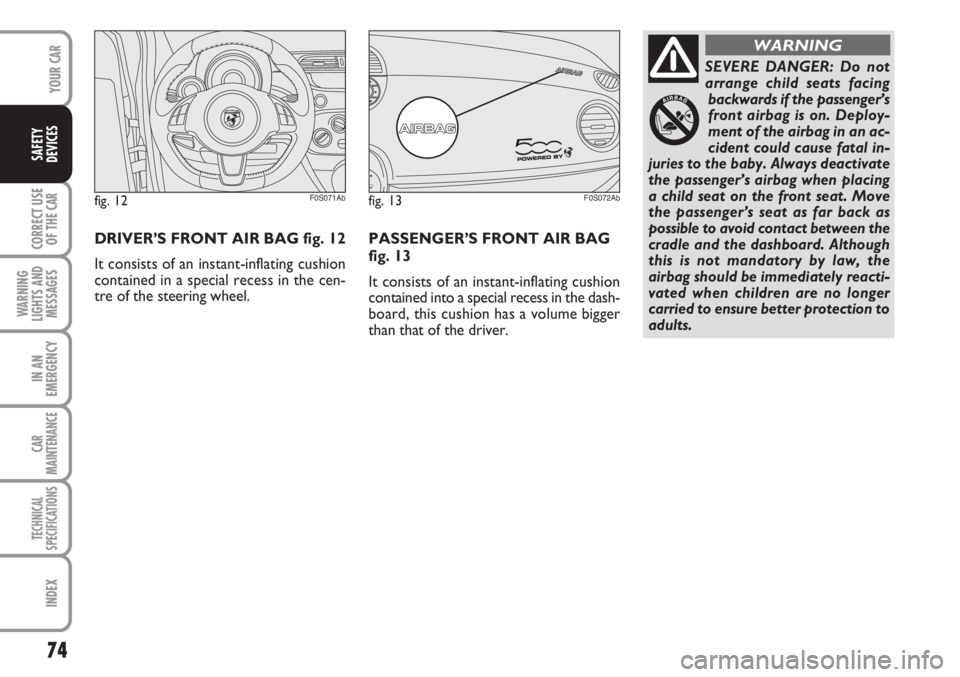
74
CORRECT USE
OF THE
CAR
WARNING
LIGHTS AND
MESSAGES
IN AN
EMERGENCY
CAR
MAINTENANCE
TECHNICAL
SPECIFICATIONS
INDEX
YOUR CAR
SAFETY
DEVICES
SEVERE DANGER: Do not
arrange child seats facing
backwards if the passenger’s
front airbag is on. Deploy-
ment of the airbag in an ac-
cident could cause fatal in-
juries to the baby. Always deactivate
the passenger’s airbag when placing
a child seat on the front seat. Move
the passenger’s seat as far back as
possible to avoid contact between the
cradle and the dashboard. Although
this is not mandatory by law, the
airbag should be immediately reacti-
vated when children are no longer
carried to ensure better protection to
adults.
WARNING
DRIVER’S FRONT AIR BAG fig. 12
It consists of an instant-inflating cushion
contained in a special recess in the cen-
tre of the steering wheel.
fig. 12F0S071Abfig. 13F0S072Ab
PASSENGER’S FRONT AIR BAG
fig. 13
It consists of an instant-inflating cushion
contained into a special recess in the dash-
board, this cushion has a volume bigger
than that of the driver.
Page 76 of 170

75
CORRECT USE
OF THE
CAR
WARNING
LIGHTS AND
MESSAGES
IN AN
EMERGENCY
CAR
MAINTENANCE
TECHNICAL
SPECIFICATIONS
INDEX
YOUR CAR
SAFETY
DEVICES
DRIVER’S KNEES AIR BAG fig. 14
It consists of an instant-inflating cushion
housed into a special compartment pro-
vided for the purpose under the lower
post guard at driver’s knees level, designed
to give further protection in the event of
frontal crash.MANUAL DEACTIVATION OF
PASSENGER’S FRONT AIR BAG
AND SIDE BAG
Should it be absolutely necessary to car-
ry a child on the front seat, the passenger’s
front air bag and the Side Bag can be de-
activated.
The instrument panel warning light
“will
stay on glowing steadily until reactivating
the passenger’s front air bag and the Side
Bag.
WARNING To deactivate the passenger’s
front air bag and the Side Bag, refer to
paragraphs “Digital display” and “Multi-
functional display” in section “Your car”.
SIDE BAGS -
WINDOW BAGS
SIDE BAG fig. 15
It consists of an instant-inflating cushion
housed in the front seat backrest. It pro-
tects the chest and the hips of the pas-
sengers in the event of side crash of medi-
um-high severity.
fig. 14F0S073Ab
Page 77 of 170
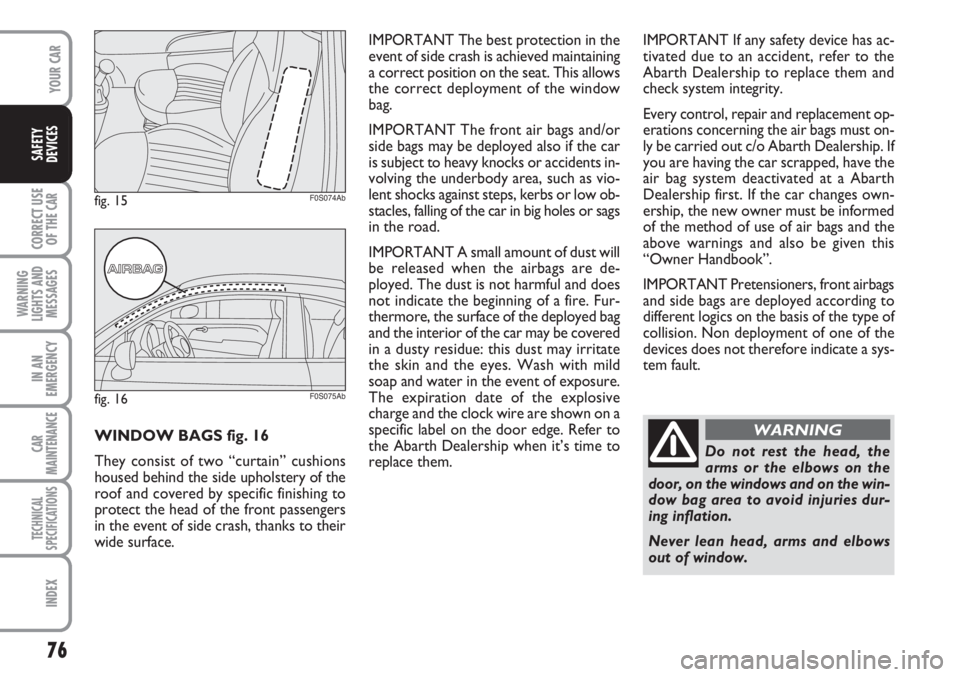
76
CORRECT USE
OF THE
CAR
WARNING
LIGHTS AND
MESSAGES
IN AN
EMERGENCY
CAR
MAINTENANCE
TECHNICAL
SPECIFICATIONS
INDEX
YOUR CAR
SAFETY
DEVICES
Do not rest the head, the
arms or the elbows on the
door, on the windows and on the win-
dow bag area to avoid injuries dur-
ing inflation.
Never lean head, arms and elbows
out of window.
WARNINGWINDOW BAGS fig. 16
They consist of two “curtain” cushions
housed behind the side upholstery of the
roof and covered by specific finishing to
protect the head of the front passengers
in the event of side crash, thanks to their
wide surface.IMPORTANT The best protection in the
event of side crash is achieved maintaining
a correct position on the seat. This allows
the correct deployment of the window
bag.
IMPORTANT The front air bags and/or
side bags may be deployed also if the car
is subject to heavy knocks or accidents in-
volving the underbody area, such as vio-
lent shocks against steps, kerbs or low ob-
stacles, falling of the car in big holes or sags
in the road.
IMPORTANT A small amount of dust will
be released when the airbags are de-
ployed. The dust is not harmful and does
not indicate the beginning of a fire. Fur-
thermore, the surface of the deployed bag
and the interior of the car may be covered
in a dusty residue: this dust may irritate
the skin and the eyes. Wash with mild
soap and water in the event of exposure.
The expiration date of the explosive
charge and the clock wire are shown on a
specific label on the door edge. Refer to
the Abarth Dealership when it’s time to
replace them.
fig. 16F0S075Ab
fig. 15F0S074Ab
IMPORTANT If any safety device has ac-
tivated due to an accident, refer to the
Abarth Dealership to replace them and
check system integrity.
Every control, repair and replacement op-
erations concerning the air bags must on-
ly be carried out c/o Abarth Dealership. If
you are having the car scrapped, have the
air bag system deactivated at a Abarth
Dealership first. If the car changes own-
ership, the new owner must be informed
of the method of use of air bags and the
above warnings and also be given this
“Owner Handbook”.
IMPORTANT Pretensioners, front airbags
and side bags are deployed according to
different logics on the basis of the type of
collision. Non deployment of one of the
devices does not therefore indicate a sys-
tem fault.
Page 78 of 170
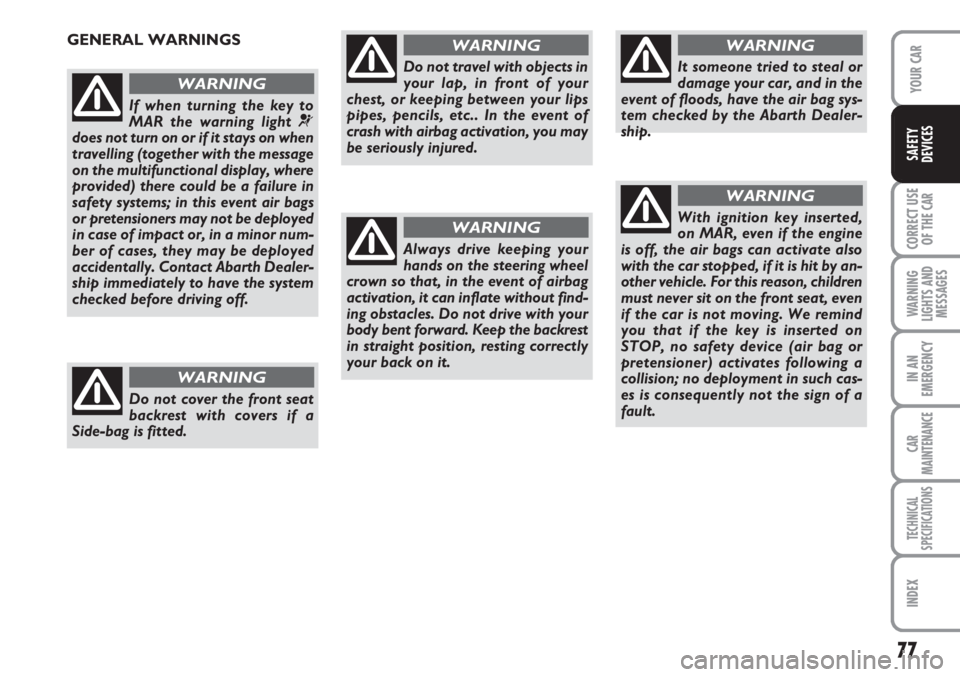
77
CORRECT USE
OF THE
CAR
WARNING
LIGHTS AND
MESSAGES
IN AN
EMERGENCY
CAR
MAINTENANCE
TECHNICAL
SPECIFICATIONS
INDEX
YOUR CAR
SAFETY
DEVICES
GENERAL WARNINGS
If when turning the key to
MAR the warning light ¬does not turn on or if it stays on when
travelling (together with the message
on the multifunctional display, where
provided) there could be a failure in
safety systems; in this event air bags
or pretensioners may not be deployed
in case of impact or, in a minor num-
ber of cases, they may be deployed
accidentally. Contact Abarth Dealer-
ship immediately to have the system
checked before driving off.
WARNING
Do not cover the front seat
backrest with covers if a
Side-bag is fitted.
WARNING
Do not travel with objects in
your lap, in front of your
chest, or keeping between your lips
pipes, pencils, etc.. In the event of
crash with airbag activation, you may
be seriously injured.
WARNING
Always drive keeping your
hands on the steering wheel
crown so that, in the event of airbag
activation, it can inflate without find-
ing obstacles. Do not drive with your
body bent forward. Keep the backrest
in straight position, resting correctly
your back on it.
WARNINGWith ignition key inserted,
on MAR, even if the engine
is off, the air bags can activate also
with the car stopped, if it is hit by an-
other vehicle. For this reason, children
must never sit on the front seat, even
if the car is not moving. We remind
you that if the key is inserted on
STOP, no safety device (air bag or
pretensioner) activates following a
collision; no deployment in such cas-
es is consequently not the sign of a
fault.
WARNING
It someone tried to steal or
damage your car, and in the
event of floods, have the air bag sys-
tem checked by the Abarth Dealer-
ship.
WARNING
Page 79 of 170

78
CORRECT USE
OF THE
CAR
WARNING
LIGHTS AND
MESSAGES
IN AN
EMERGENCY
CAR
MAINTENANCE
TECHNICAL
SPECIFICATIONS
INDEX
YOUR CAR
SAFETY
DEVICES
Do not wash the seats with
pressurized water or steam
(manually or at the automatic wash-
ing stations).
WARNING
Front air bag activation if
foreseen in case of more se-
vere collisions compared with pre-
tensioner activation. For collisions in
the range between the two activation
thresholds, the fact that only the pre-
tensioners activate is normal.
WARNING
Do not hook rigid objects to
cloth hangers and to the
support handles.
WARNING
The air bag does not replace
the safety belts, it increases
their effectiveness. Furthermore, since
front airbags are not deployed in low
speed collisions, side collisions, rear-
end shunts or roll-overs, the occu-
pants are only protected by the seat
belts which must be fastened at all
times.
WARNING
Rotating the key on MAR,
the warning light “turns on,
blinking for a few seconds, to remind
that the passenger air bag will acti-
vate in the event of a collision, then
it turns off.
WARNING
Page 80 of 170

79
WARNING
LIGHTS AND
MESSAGES
IN AN
EMERGENCY
CAR
MAINTENANCE
TECHNICAL
SPECIFICATIONS
INDEX
YOUR CAR
SAFETY
DEVICES
CORRECT USE
OF THE CAR
STARTING THE ENGINE ................................................. 80
HANDBRAKE ....................................................................... 81
USING THE MANUAL GEARBOX ................................. 82
CONTAINING RUNNING COSTS................................. 82
SNOW TYRES....................................................................... 84
SNOW CHAINS................................................................... 85
CAR INACTIVITY ............................................................... 85
CC C
O O
R R
R R
E E
C C
T T
U U
S S
E E
O O
F F
T T
H H
E E
C C
A A
R R
Page 81 of 170
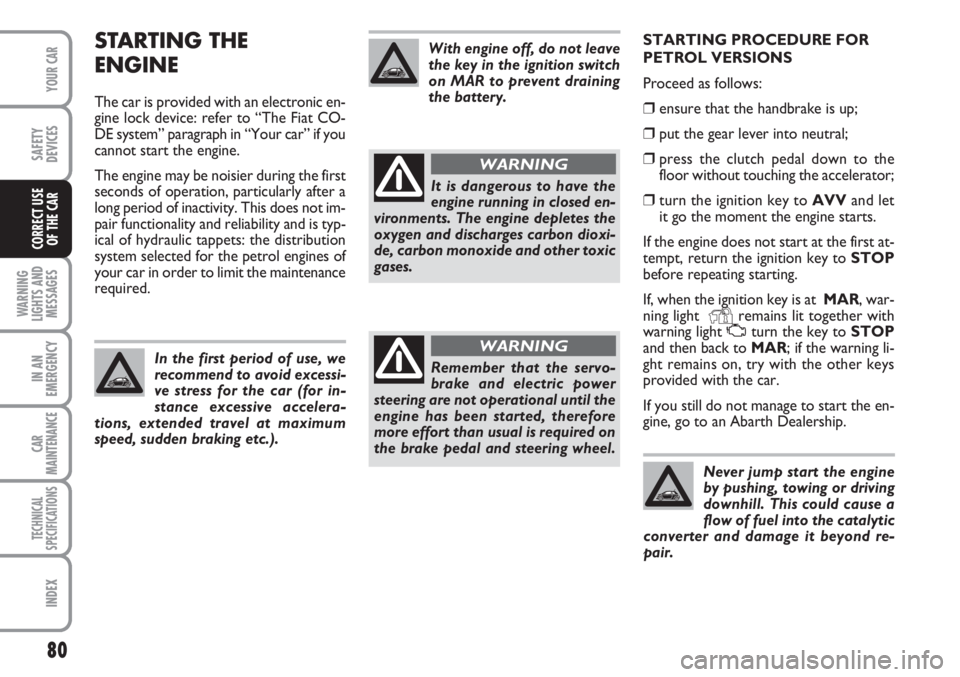
80
WARNING
LIGHTS AND
MESSAGES
IN AN
EMERGENCY
CAR
MAINTENANCE
TECHNICAL
SPECIFICATIONS
INDEX
YOUR CAR
SAFETY
DEVICES
CORRECT USE
OF THE CAR
STARTING PROCEDURE FOR
PETROL VERSIONS
Proceed as follows:
❒ensure that the handbrake is up;
❒put the gear lever into neutral;
❒press the clutch pedal down to the
floor without touching the accelerator;
❒turn the ignition key to AVVand let
it go the moment the engine starts.
If the engine does not start at the first at-
tempt, return the ignition key to STOP
before repeating starting.
If, when the ignition key is at MAR, war-
ning light
Yremains lit together with
warning light Uturn the key to STOP
and then back to MAR; if the warning li-
ght remains on, try with the other keys
provided with the car.
If you still do not manage to start the en-
gine, go to an Abarth Dealership.
STARTING THE
ENGINE
The car is provided with an electronic en-
gine lock device: refer to “The Fiat CO-
DE system” paragraph in “Your car” if you
cannot start the engine.
The engine may be noisier during the first
seconds of operation, particularly after a
long period of inactivity. This does not im-
pair functionality and reliability and is typ-
ical of hydraulic tappets: the distribution
system selected for the petrol engines of
your car in order to limit the maintenance
required.
In the first period of use, we
recommend to avoid excessi-
ve stress for the car (for in-
stance excessive accelera-
tions, extended travel at maximum
speed, sudden braking etc.).
With engine off, do not leave
the key in the ignition switch
on MAR to prevent draining
the battery.
It is dangerous to have the
engine running in closed en-
vironments. The engine depletes the
oxygen and discharges carbon dioxi-
de, carbon monoxide and other toxic
gases.
WARNING
Remember that the servo-
brake and electric power
steering are not operational until the
engine has been started, therefore
more effort than usual is required on
the brake pedal and steering wheel.
WARNING
Never jump start the engine
by pushing, towing or driving
downhill. This could cause a
flow of fuel into the catalytic
converter and damage it beyond re-
pair.
Page 82 of 170
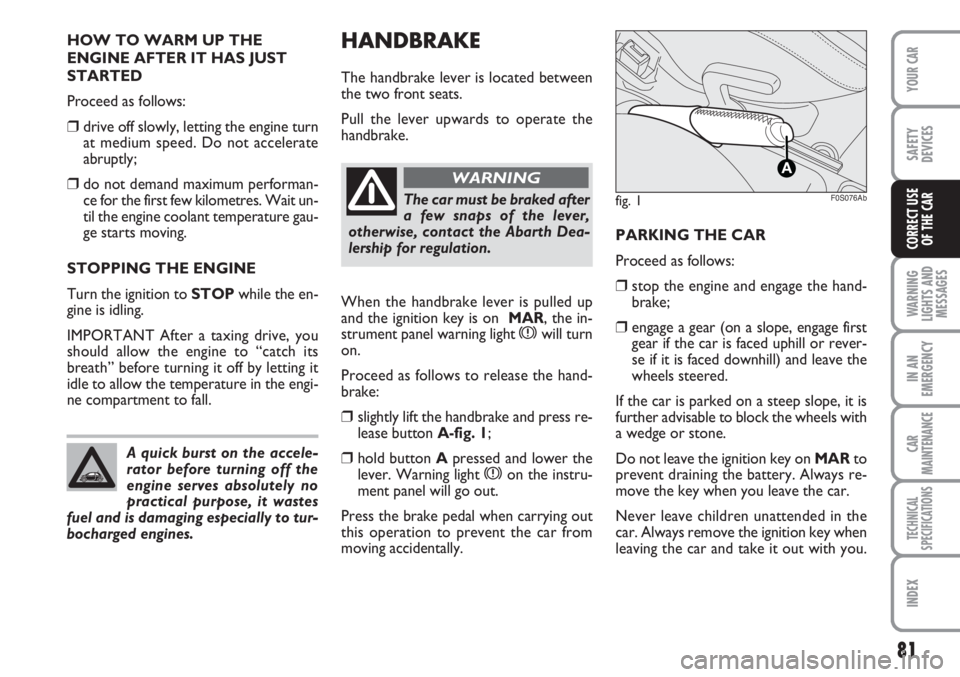
81
WARNING
LIGHTS AND
MESSAGES
IN AN
EMERGENCY
CAR
MAINTENANCE
TECHNICAL
SPECIFICATIONS
INDEX
YOUR CAR
SAFETY
DEVICES
CORRECT USE
OF THE CAR
HANDBRAKE
The handbrake lever is located between
the two front seats.
Pull the lever upwards to operate the
handbrake.
PARKING THE CAR
Proceed as follows:
❒stop the engine and engage the hand-
brake;
❒engage a gear (on a slope, engage first
gear if the car is faced uphill or rever-
se if it is faced downhill) and leave the
wheels steered.
If the car is parked on a steep slope, it is
further advisable to block the wheels with
a wedge or stone.
Do not leave the ignition key on MARto
prevent draining the battery. Always re-
move the key when you leave the car.
Never leave children unattended in the
car. Always remove the ignition key when
leaving the car and take it out with you. HOW TO WARM UP THE
ENGINE AFTER IT HAS JUST
STARTED
Proceed as follows:
❒drive off slowly, letting the engine turn
at medium speed. Do not accelerate
abruptly;
❒do not demand maximum performan-
ce for the first few kilometres. Wait un-
til the engine coolant temperature gau-
ge starts moving.
STOPPING THE ENGINE
Turn the ignition to STOPwhile the en-
gine is idling.
IMPORTANT After a taxing drive, you
should allow the engine to “catch its
breath” before turning it off by letting it
idle to allow the temperature in the engi-
ne compartment to fall.
A quick burst on the accele-
rator before turning off the
engine serves absolutely no
practical purpose, it wastes
fuel and is damaging especially to tur-
bocharged engines.The car must be braked after
a few snaps of the lever,
otherwise, contact the Abarth Dea-
lership for regulation.
WARNING
When the handbrake lever is pulled up
and the ignition key is on MAR, the in-
strument panel warning light
xwill turn
on.
Proceed as follows to release the hand-
brake:
❒slightly lift the handbrake and press re-
lease button A-fig. 1;
❒hold button Apressed and lower the
lever. Warning light xon the instru-
ment panel will go out.
Press the brake pedal when carrying out
this operation to prevent the car from
moving accidentally.
fig. 1
A
F0S076Ab